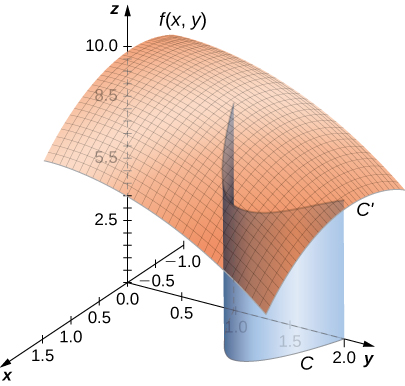| << Chapter < Page | Chapter >> Page > |

You may have noticed a difference between this definition of a scalar line integral and a single-variable integral. In this definition, the arc lengths aren’t necessarily the same; in the definition of a single-variable integral, the curve in the x -axis is partitioned into pieces of equal length. This difference does not have any effect in the limit. As we shrink the arc lengths to zero, their values become close enough that any small difference becomes irrelevant.
Let be a function with a domain that includes the smooth curve that is parameterized by The scalar line integral of along is
if this limit exists and are defined as in the previous paragraphs). If C is a planar curve, then C can be represented by the parametric equations and If C is smooth and is a function of two variables, then the scalar line integral of along C is defined similarly as
if this limit exists.
If is a continuous function on a smooth curve C , then always exists. Since is defined as a limit of Riemann sums, the continuity of is enough to guarantee the existence of the limit, just as the integral exists if g is continuous over
Before looking at how to compute a line integral, we need to examine the geometry captured by these integrals. Suppose that for all points on a smooth planar curve Imagine taking curve and projecting it “up” to the surface defined by thereby creating a new curve that lies in the graph of ( [link] ). Now we drop a “sheet” from down to the xy-plane. The area of this sheet is If for some points in then the value of is the area above the xy-plane less the area below the xy-plane. (Note the similarity with integrals of the form

From this geometry, we can see that line integral does not depend on the parameterization of C . As long as the curve is traversed exactly once by the parameterization, the area of the sheet formed by the function and the curve is the same. This same kind of geometric argument can be extended to show that the line integral of a three-variable function over a curve in space does not depend on the parameterization of the curve.
Find the value of integral where is the upper half of the unit circle.
The integrand is [link] shows the graph of curve C , and the sheet formed by them. Notice that this sheet has the same area as a rectangle with width and length 2. Therefore,

To see that using the definition of line integral, we let be a parameterization of C . Then, for any number in the domain of r . Therefore,

Notification Switch
Would you like to follow the 'Calculus volume 3' conversation and receive update notifications?